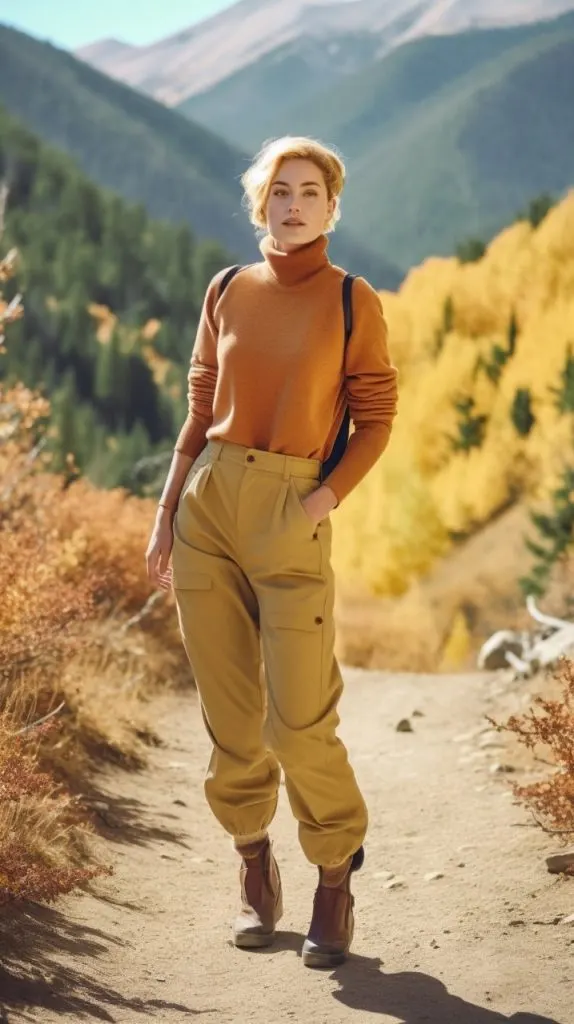Fall is a beautiful time of year to hit the trails and enjoy the crisp, cool air and stunning foliage. However, it’s important to dress properly for fall hiking to ensure a comfortable and safe experience. The weather in the fall can be unpredictable, with sudden drops in temperature and changing conditions, so dressing in layers is key. Proper clothing can also protect against sunburn, insect bites, and scratches from branches and brush.

Why Dressing Properly for Fall Hiking is Important
Hiking in the fall can present a unique set of challenges, including changes in weather, trail conditions, and daylight hours. Therefore, dressing appropriately is crucial to ensure a safe and enjoyable experience. Here are some reasons why dressing properly for fall hiking is important:
- Prevent hypothermia: As temperatures drop, it’s important to dress in layers to prevent hypothermia, a potentially life-threatening condition that occurs when the body loses heat faster than it can produce it.
- Protect against sunburn: Even though the sun may not feel as intense in the fall, it’s important to protect your skin from harmful UV rays by wearing sunscreen and appropriate clothing.
- Stay comfortable: Dressing in layers allows you to easily regulate your body temperature as you hike, keeping you comfortable and dry.
- Prevent injuries: Wearing the right clothing and footwear can help prevent injuries such as blisters, scrapes, and bruises from rough terrain and vegetation.
Factors to Consider When Choosing Fall Hiking Clothing

When choosing clothing for fall hiking, it’s important to consider the following factors:
- Weather: Be prepared for changing weather conditions by dressing in layers and packing a rain jacket or other waterproof gear.
- Trail conditions: Consider the terrain and vegetation you’ll be hiking through and choose clothing that will protect against scratches, insect bites, and other hazards.
- Length and difficulty of the hike: Longer, more strenuous hikes may require more advanced clothing and gear to keep you comfortable and safe.
- Personal preference: Everyone’s body is different, so it’s important to choose clothing that you feel comfortable and confident in.


By considering these factors, you can choose the right clothing for your fall hiking adventure and ensure a safe and comfortable experience.
Considerations when choosing fall hiking clothing, such as weather and terrain
Fall weather can be unpredictable and can vary depending on the location and time of day. Therefore, it is important to consider the weather and terrain when choosing what to wear for a fall hike. Here are some factors to consider:
Weather
- Temperature: The temperature can change quickly, especially at higher elevations. Check the forecast and dress in layers to adjust to temperature changes throughout the day.
- Precipitation: Be prepared for rain or snow by bringing waterproof and wind-resistant clothing. Remember to pack a rain jacket and pants, and consider bringing a poncho or umbrella.
- Sun protection: Even though the temperatures may be cooler, the sun can still be strong. Wear a hat, sunglasses, and sunscreen to protect your skin.
Terrain
- Difficulty level: The difficulty of the hike will impact what clothing you should wear. For example, a strenuous hike may require lighter clothing to prevent overheating, while a leisurely hike may allow for heavier layers.
- Vegetation: Consider the type of vegetation you will encounter on the hike, such as brush or thorns, and wear appropriate clothing to avoid scratches and cuts.
- Altitude: The higher the altitude, the cooler the temperatures will be. Be prepared for colder temperatures and stronger winds.
By considering the weather and terrain, you can choose appropriate clothing that will keep you comfortable and safe throughout your fall hiking experience.


Clothing recommendations for fall hiking, including layering and materials
Fall weather can be unpredictable, and temperatures can vary greatly throughout the day. Therefore, it’s important to dress in layers when hiking in the fall. This will allow you to easily adjust your clothing as needed and stay comfortable throughout your hike.
Base Layer
The base layer is the layer of clothing closest to your skin. It should be made of moisture-wicking material that will keep sweat away from your skin and prevent you from getting cold. Avoid cotton, as it retains moisture and can lead to chills. Instead, opt for synthetic fabrics such as polyester or merino wool.
Middle Layer
The middle layer provides insulation and helps regulate your body temperature. This layer should also be made of moisture-wicking material, and can be a fleece or down jacket, depending on the weather conditions. Make sure the middle layer is not too tight, as you’ll need to fit additional layers over it.
Outer Layer
The outer layer is your first line of defense against the elements. It should be windproof and waterproof to protect you from rain, snow, and wind. Look for a jacket that has breathable material to prevent you from overheating. A hardshell jacket or a softshell jacket with a waterproof membrane are great options.
Pants
When it comes to pants, choose a pair made of a quick-drying material such as nylon or polyester. Avoid jeans or cotton pants, as they retain moisture and can lead to chills. Depending on the weather, you may want to wear insulated pants or tights underneath your hiking pants.
Footwear
Choose hiking boots that are comfortable, supportive, and waterproof. Look for boots with a sturdy sole and good ankle support to protect your feet and prevent injuries. If the weather is dry, you can opt for hiking shoes or trail runners.
Accessories
Don’t forget to bring along accessories such as a hat, gloves, and socks. A beanie or hat will help keep your head warm, while gloves will protect your hands from the cold. Socks made of wool or synthetic materials will help wick away moisture and prevent blisters.


Table: Recommended Clothing Materials for Fall Hiking
| Layer | Recommended Materials |
|---|---|
| Base Layer | Polyester or Merino Wool |
| Middle Layer | Fleece or Down Jacket |
| Outer Layer | Hardshell or Softshell with Waterproof Membrane |
| Pants | Nylon or Polyester |
| Footwear | Hiking Boots or Shoes |
By following these clothing recommendations, you’ll be well-prepared for a comfortable and enjoyable fall hiking experience. Remember to dress in layers and choose materials that will keep you dry and warm, and don’t forget to bring along appropriate accessories.
Accessories to Consider for Fall Hiking, Such as Hats, Gloves, and Socks
When planning a fall hike, it’s important to not only consider the clothing you’ll wear, but also the accessories that can make a big difference in keeping you warm and comfortable on the trail. Here are some essential accessories to consider:
Hats
A hat is a must-have accessory for fall hiking, as it helps to keep your head and ears warm, which is essential for maintaining your body temperature. A good hat should be made of a warm, breathable material such as wool or fleece, and should cover your ears and forehead.
If you’re hiking in windy conditions, consider a hat with ear flaps or a chin strap to keep it in place. Additionally, a hat with a brim can help to shield your face from the sun and rain, which can be especially important in areas with unpredictable weather.
Gloves
Gloves are another essential accessory for fall hiking, as they help to keep your hands warm and protected from the elements. Look for gloves made of a warm, breathable material such as wool or fleece, and consider gloves with a grip on the palm to help you hold onto hiking poles or rocks.
If you’re hiking in wet conditions, consider gloves made of waterproof material to keep your hands dry. Additionally, gloves with touch screen compatibility can be helpful if you need to use your phone or other electronic devices while on the trail.
Socks
Socks are often overlooked when planning a hiking outfit, but they can make a big difference in keeping your feet warm and comfortable on the trail. Look for socks made of a warm, moisture-wicking material such as wool or synthetic blends, and consider socks that come up to your mid-calf for extra warmth.
If you’re hiking in wet conditions, consider waterproof socks to keep your feet dry. Additionally, socks with extra cushioning can help to prevent blisters and provide additional comfort on longer hikes.


Other Accessories
Other accessories to consider for fall hiking include:
- Scarf or neck gaiter to keep your neck and face warm
- Sunglasses to protect your eyes from the sun
- Sunscreen to protect your skin from the sun
- Insect repellent to keep bugs at bay
- A backpack to carry extra layers and accessories
By considering these essential accessories for fall hiking, you’ll be well-prepared to tackle the trails in comfort and style, no matter the weather conditions.


Conclusion
As you prepare for your fall hiking adventure, keep in mind that dressing appropriately can make all the difference in your comfort and safety. By following these tips, you’ll be ready to tackle the changing weather and terrain:
1. Layer Up
Layering your clothing is key to staying comfortable during fall hikes. Start with a moisture-wicking base layer, add a insulating mid-layer, and top it off with a waterproof and windproof outer layer. This way, you can easily adjust your clothing to accommodate for changes in temperature and weather.
2. Choose the Right Materials
When selecting fall hiking clothing, choose materials that are breathable, moisture-wicking, and quick-drying. Avoid cotton, as it retains moisture and can lead to hypothermia. Instead, opt for synthetic fabrics or wool blends.
3. Don’t Forget Your Accessories
Accessories like hats, gloves, and socks can make a big difference in your comfort level. Choose wool or synthetic materials to keep your hands and feet warm and dry. A hat can also help regulate your body temperature, and protect you from the sun or wind.
4. Check the Weather and Terrain
Before heading out, always check the weather forecast and research the terrain. This will help you determine the appropriate clothing and gear needed for your hike.
5. Be Prepared for Emergencies
Finally, always be prepared for emergencies. Bring extra clothing, food, water, and a first-aid kit. Let someone know where you’ll be hiking and when you plan to return.
By following these tips, you’ll be well-prepared for a comfortable and safe fall hiking experience. Happy trails!

What To Wear On Hiking Date: Tips For Outdoor Adventurers
Thursday 27th of April 2023
[…] strike the perfect balance between being comfortable and looking good! Be sure to check out post on what to wear hiking in the fall! I share some easy tips to […]